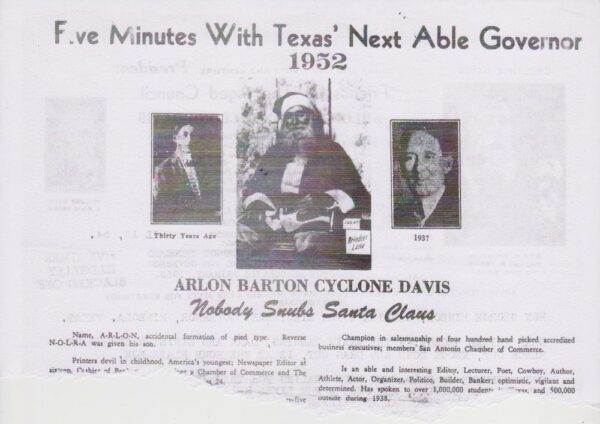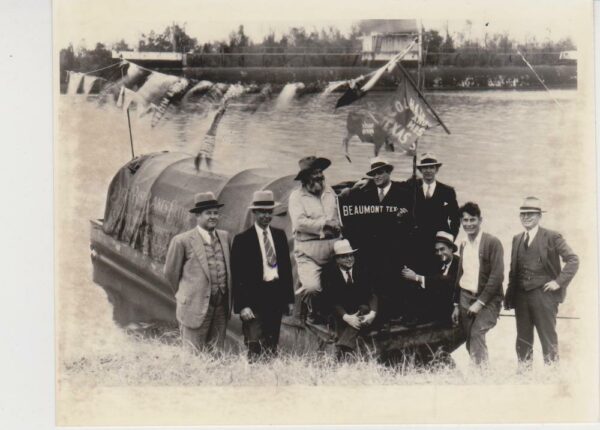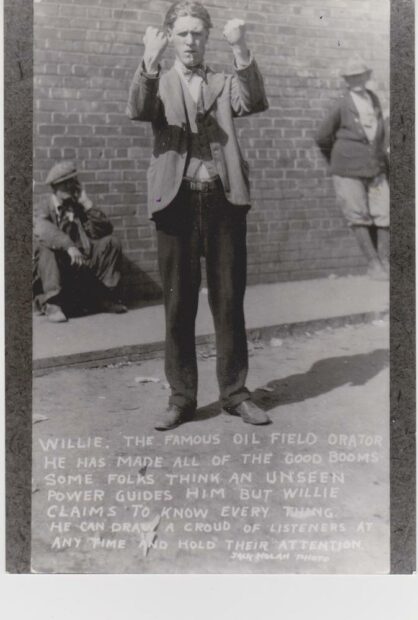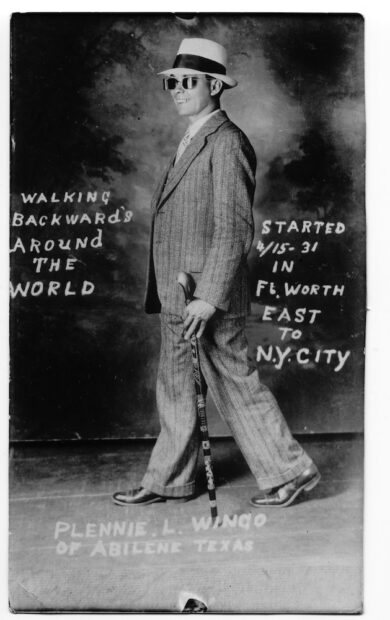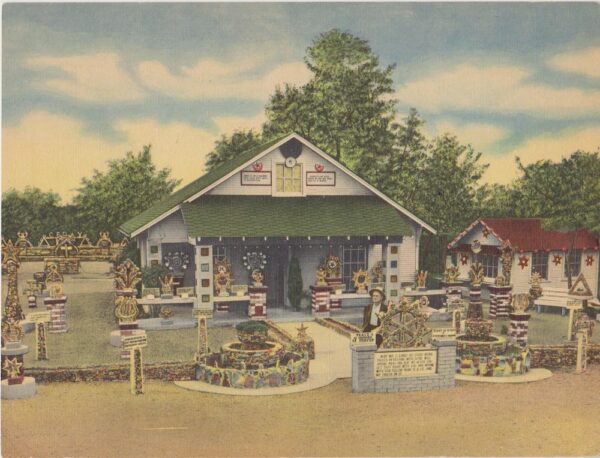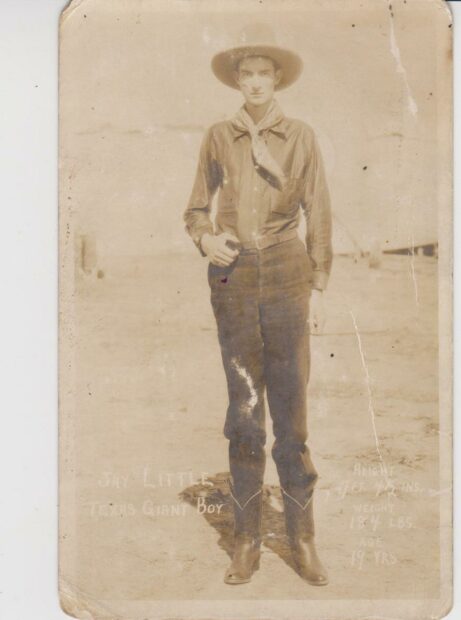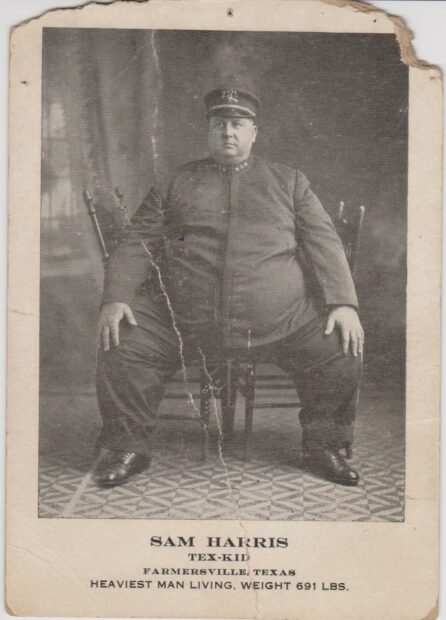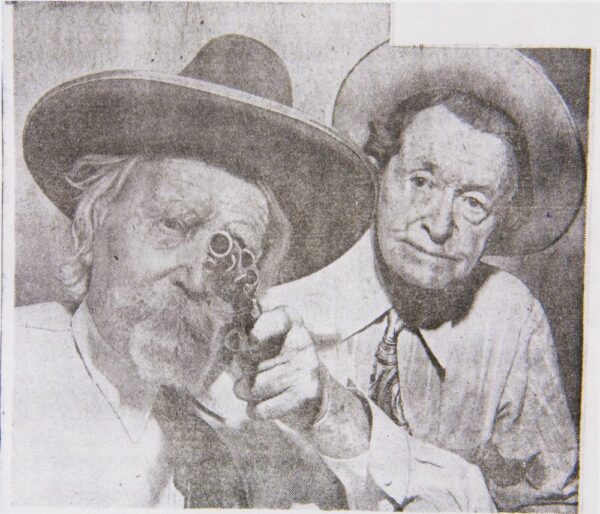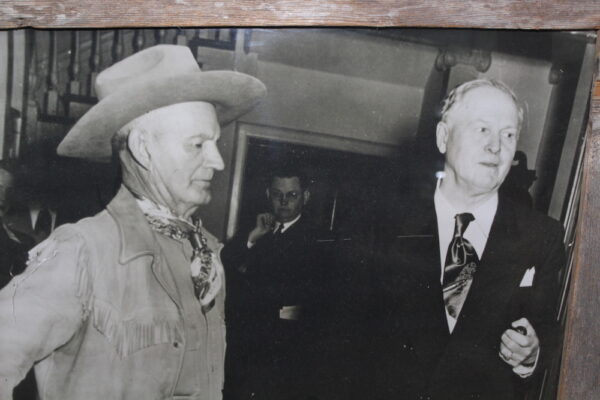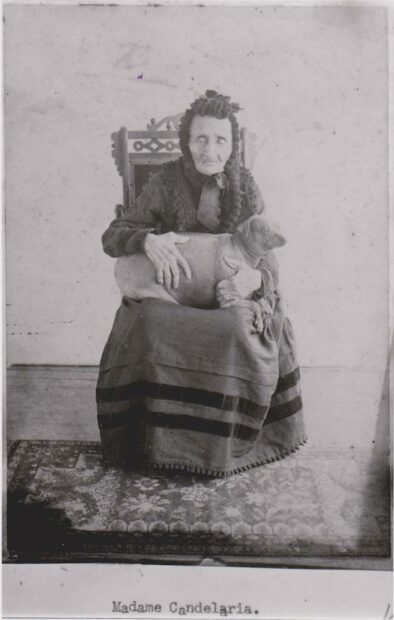Decades ago, I accidentally began collecting stories and images of Texans who carried out unusual activities in the past. In time, I came to see these people’s actions and adapted states of being in a contemporary art context. I came to see the individuals as outsider artists who engaged in performance and conceptual art. Here are some of their stories.
Pressing the Flesh
Vermin Supreme will probably not be elected president this year. It might have been interesting, had he been allowed to take the debate stage with Biden and Trump, to hear his strategy for combatting the pandemic. (It also would have been nice for every American to receive a free pony! It was a campaign promise.) But Supreme brings to mind the great Texas outsider Cyclone Davis Jr. “How can I lose?” asked the septuagenarian and self-proclaimed “bewhiskered dervish” when announcing his candidacy for president in 1954. “I’m an international character. I’ve talked face to face with more people than any politician who ever lived. Besides that, I’m a freak of nature: I haven’t been sick — not even a headache — in over sixty years. People are bound to vote for a healthy politician.”
Unfortunately, Cyclone died that same year. In addition to leader of the free world, he had run for Texas governor, lieutenant governor, U. S. Congress, and U. S. Senate, but the only elected office he is known to have won is mayor of Rotan, Texas in 1906. In Rotan, northwest of Abilene, he masterminded “the first bank named for, owned by, and operated by cowboys.” Calling himself the “Texas Bank Wizard,” Cyclone also introduced himself as “the best durned fender repairman in Texas.” While running for Senate in 1941, he established a campaign office in an improvised recycling shop underneath the Dallas viaduct. “But I don’t need to campaign,” Cyclone told Life magazine. “Providence will place me in the Senate.”
Known to lead snake dances at his rallies, Cyclone’s 1952 gubernatorial campaign literature featured a photograph of himself dressed as Saint Nick with the slogan, “Nobody Snubs Santa Claus.” The text described him as “an able and interesting Editor, Lecturer, Poet, Cowboy, Author, Athlete, Actor, Organizer, Politico, Builder, and Banker.” When the optimistic multi-tasker fell ill in 1954, hospital switchboards were jammed with concerned callers. Earlier that same year, Cyclone had proclaimed: “The National Thinker’s Council, 530,000 Friends of the Aged Councils, the Texas Pension Association, the American Brush Club, and some few boneheads have filed their 73 year-old champion protagonist of Tom Paine’s Rights of Man for governor of gullible, galloping Texas. Cyclone Davis, the bewhiskered sage of Sulphur Springs, for twenty years a resident of Dallas, and perpetually importuned for forty years to run for public office, dollar-drafted by every state in the nation, three foreign countries, and the District of Columbia, has of recent years responded to that appeal by running for almost every office under the sun.”
“TWENTY-SEVEN CANDIDATES SEEK SENATE SEAT IN SCREWY TEXAS RACE,” announced a Life magazine headline in 1941. Among those pictured in the article, Fort Worth candidate Commodore Basil Muse Hatfield, another bearded political prophet, could also be considered a land artist and an endurance artist. Hatfield’s thing was the Trinity River, and in the 1930s he announced that he would not shave or cut his hair again until the Trinity had been canalized to create an inland port at Dallas/Fort Worth. To publicize that quest, the commodore piloted a 24-foot flat-bottomed boat over inland waterways from Fort Worth to Chicago during the Windy City’s Century of Progress International Exposition of 1933. Along the way, countless reporters heard Hatfield’s testimony about the magic Trinity, “more fertile than the fabled Nile.”
The commodore had been Colonel Hatfield when folks read about his minor tour de force performance in the Fort Worth Press in 1932. Claiming “squatter’s rights,” Hatfield attempted to have a telephone installed in his “office,” an eight-inch gap between the Hotel Texas and the Worth Building. When the phone company rep protested, the colonel lamented America’s loss of a sense of humor. Before becoming a colonel, Hatfield had been a world traveler and adventurer. In Tibet, he told reporters, lamas taught him patience by instructing him to transfer sand from one bucket to another, one grain at a time.
Another political performer, Henry Ralph Wooley, arrived in Kilgore during the East Texas oil boom in 1931, having perfected his oratorical style in other Texas boomtowns. As local photographer Jack Nolan put it, the artist who became known as Oil Field Willie and then Governor Willie “enjoyed a flamboyant, make-believe career.” Sometimes speaking in what appeared to be an unknown language of his own invention, he astounded listeners with “brilliant flashes of logic” that punctuated his fiery tirades. “Some folks think an unseen power guides him,” wrote Nolan, “but Willie claims to know everything.”
Trek Stars: Endurance Performance
Abilene restaurateur Plennie L. Wingo set out to walk backwards around the world in the spring of 1931. He trained with a chiropractor who warned that the practice might be “against nature” and obtained special glasses with rear-view mirrors. You can catch him reversing through Chicago here. Selling postcards of himself in backwards stride to finance the trip, he backed down the gangplank at Boston Harbor to head overseas. In Istanbul, his peculiar locomotion got him thrown in the pokey. Authorities feared some social or cosmic ill if they allowed him to continue the odd pilgrimage through Asia, so he returned to the West Coast and walked backwards to Fort Worth, arriving October 24, 1932. Wingo had worn out 13 pairs of shoes and lost 36 pounds on the trip. As he strode in reverse near Mineral Wells, the home of Crazy Water, an old-timer who had been taking the waters advised, “You take a few of them baths, and you’ll be able to turn around and walk forwards as good as ever.”
San Benito cowboy Ralph Sanders gained weight on his journey from Brownsville to New York City aboard a bull named Jerry, who also bulked up while grinding down seven sets of steel shoes. Sanders trained Jerry for 95 days before setting out in May, 1930. Some 254 days later, the pair sauntered down Broadway, and Sanders presented NYC Mayor Jimmy Walker with a 51-inch pair of steer’s horns. “I just wanted to ride a bull,” the 28 year-old cowboy told The Associated Press. “It’s something that ain’t been done before on such a large scale. Bull riding sure is healthful, though. I feel better than I’ve felt in five years.”
Harm Bates “Hoopie” Williams set out in 1929 to roll a hoop from Texas City to New York. Made of steel and named Irma, Hoopie’s hoop measured 48 inches around with an inch-wide tread. Bates rolled Irma along with a bamboo pole enhanced with a steel crossbar to meet the specifications of the International Association of Hoop Rollers. It took six months to roll Irma to NYC, and she was two inches smaller afterward. Hoopie lost 15 pounds. In 1934, perhaps inspired by Plennie Wingo’s performance, Bates announced that he would drive a car backward from Houston to New York, but there is no record that he completed the action.
Installation and Train Art
A roadside installation in Stephenville drew art enthusiasts from all over the country from the 1940s to the 1960s. Created by homespun philosopher George Ellis Ray, the yard art consisted mostly of concrete sculptures decorated with radio tubes, colored glass, tiles, shells, and petrified wood. Tarleton State College reporters described the assemblage of pieces depicting stars, hearts, lyres, and “designs never before thought of” as a “mecca for lovers of the unusual and the bizarre.”
“That man must be crazy to do such as thing as this,” remarked one visitor in the 1950s. She was then startled to hear Ray retort, over speakers placed throughout the work, “Well what difference does it make? A man’s got to be crazy about something.” In its gradual passage to ruin (it’s largely gone today), Tarleton rodeo boys used the works for roping practice.
Dallas artist Martin Delabano visited the site as a boy with his artist father, Barney Charles Delabano, who was employed by the Dallas Museum of Art. The younger Delabano, who launched a Facebook group devoted to the site , believes the DMA’s former director, celebrated regional painter Jerry Bywaters, also visited the installation.
In the 1920s, ‘30s, and probably into the ‘40s, San Antonio railroad worker J.H. McKinley created more than 250,000 identical works of art that were viewed all over North America. Working under the name Bozo Texino, his innumerable multiples were drawn on the sides of boxcars in waterproof yellow crayon. The image, a figure smoking a pipe and wearing a ten-gallon hat with a star on it, appeared above the artist’s signature.
More images of the “real Bozo Texino” can be seen here (scroll all the way down). A second Bozo Texino carried on the tradition in the 1970s and ‘80s, but the drawings of the latter-day Bozo lack the star on the hat and generally feature a different type of pipe. Bill Daniel’s wonderful film, Who Is Bozo Texino?, appeared around 2006.
Body Art
More than a few Texans presented their own earthly vessels as artworks long before such aesthetic poses became trendy. The four Shields brothers, originally from White Rock, Texas, forged a career as the Texas Giants. The ironically named Jay Little trouped arenas as the Texas Giant Boy. “Big Sam” Harris, from Farmersville, was curated for audiences as the 731-pound “Texas Kid.”
Identity Performance
Like Grandma Moses, some Texans resorted to art in the sunset of life. Two of our most celebrated elderly outsiders, Brushy Bill Roberts and J. Frank Dalton, engaged in the genre of identity performance, specifically by up-and-claiming to be the long-presumed-dead outlaws Billy the Kid and Jesse James. Dalton first experienced the rush of publicity as a frontier character with Old West stories in the East Texas oil field of the 1930s. Ascending to Jessehood in 1948, at the reputed age of 100, he went on a “personal appearance performance” tour, arriving at the San Francisco, California airport on a stretcher, from which he waved a six shooter.
“I don’t give a hoot whether anybody doubts I am Jesse James,” he barked at a Chicago reporter. “I am — and that’s that!” The Texas comptroller took him off of Confederate pension rolls, suspending his monthly hundred-dollar checks but said he could be reinstated if he’d quit being Jesse James. “I can make a lot more in a month being Jesse,” Dalton-James retorted, “than I ever got being Frank Dalton.” When he died in Granbury in August 1951, his last weeks spent in a small house festooned with press clippings and signs inviting folks to meet “the real Jesse James,” the Police Gazette cited his age as 104: “But his steel-blue eyes still glittered unafraid and for the last time, through thin, almost bloodless lips, the old man sneered … I am Jesse James.”
Brushy Bill Roberts of Hico, where he is remembered today with the Billy the Kid Museum and the semi-annual Billy the Kid Film Festival, either came clean and admitted he was Billy the Kid or decided he wanted to be Billy the Kid sometime in 1950. In late November of that year, Brushy/Billy appeared in Santa Fe, New Mexico with his attorney to request a pardon for his ancient misdeeds. Unconvinced that Brushy was Billy, Governor Thomas Mabry refused. A month later, he died on the streets of Hico, where his own legend soon took root.
“There’s not another like him in Texas,” wrote reporter Thomas Turner in The Dallas Morning News when Brushy died, “a straight-eyed, fast-talking little man who spun a wondrous tale. And it was a fascinating yarn. Some of it could be verified. Around Hico, the folks sort of poked fun at his fabulous stories… . But the beauty of it was that the part of his endless tale that was true was enough. Brushy led a life that a Hollywood horse-opera writer would have discarded as too unbelievable.”
The identity aspect of Madam Candelaria’s artmaking concerns her performative claim to have been within the walls of the Alamo during the battle in 1836. In the last few decades of her life (she died in 1899 at the age of 89 or 114, according to differing accounts of her birth year), she gave thousands of performances, making “numerous expressive gesticulations” and “swaying her body to and fro in a highly dramatic style” as she related the story of her nursing and shielding of an ailing James Bowie as Mexican soldados stormed the old mission. Though the Alamo curator recently told me that he doubted her story, her descendants have continued to unearth compelling evidence supporting the claim.
Hugo Ball on the Texas Frontier?
Though Nick Cave’s Soundsuit pieces might be a more apt reference, I still can’t help thinking of Hugo Ball’s Karawane ensemble when I see photographs of Robert Hall’s fabulous Frontiersman’s Suit, adorned with the hide, fur, claws, rattles, tails, and horns of most every kind of beast that prowled 19th-century Texas and Mexico. Actor Gary Cooper modeled the outfit at the 1936 Texas Centennial celebration in Dallas.
****
Gene Fowler wrote about these artists and others in his 2008 book, Mavericks – A Gallery of Texas Characters. Speaking of books, we should mention Cyclone Davis Jr.’s 1937 volume, Offings and Musings of A. Nutt, a remarkable compendium of inscrutably miscellaneous odds and ends, including poems, riddles, jokes, cartoons, wise sayings and commonsense instruction, pictures of friends and public officials, an essay on grass, and peculiar doodles and illustrations. The cover features drawings of WFAA cowboy singer Peg Moreland and characters named Professor A-Corn, Mr. Peanut, and Miss Pickon. “With 400 years of glamour and 6,000,000 people,” Cyclone Jr. had printed on his book’s cover, “not 400 Texans have written books of 400 or more pages. THIS IS BOTH AN INDICTMENT AND A CHALLENGE.” Indeed, Offings and Musings of A. Nutt came in at a mere 235 pages.



